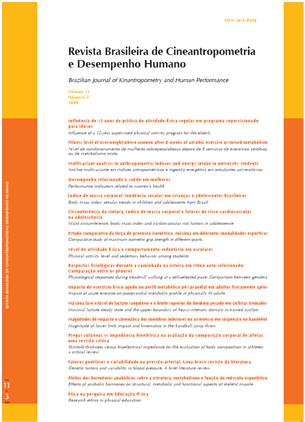Validity and reliability of the one-mile walk test (the Rockport Fitness Walk Test) among 70-to-79 year old women
DOI:
https://doi.org/10.1590/1980-0037.2009v11n3p364Resumen
The purpose of this study was to verify the reliability and concurrent validity of the One-Mile Walk Test (OMWT) (The Rockport Fitness Walk Test, Kline et al., 1987), as a preditor of the maximal oxygen consumption (VO2max) among women aged 70 to 79 years. The study used a convenient sample, composed by 30 healthy seniors from Florianópolis, SC. Data collection was structured in three phases: 1) answering questionnaires on sociodemographics, on readiness for physical activity (PAR-Q) and on physical activity level (IPAQ). Anthropometric variables were measured and the participant performed the first evaluation of the RFWT. Afterwards, the subject visited the laboratory for a treadmill walk and for a trial of the equipments (K4 b2 - COSMED) to be used during the stress test (ST) for directly measuring the VO2max; 2) the seniors performed the ST following an incremental test protocol, from 2.4 km.h-1 to 5.6 km.h-1 with grades varying from 0% to 15%; 3) the second RFWT. The statistical analyses included the criteria suggested by Lohman (1992) for validity and the procedures were performed using the SPSS (v. 7.5) and MedCalc (v. 9.1). The level of significance was established at 5%. For reliability, the generalized (GE) and sex-specific equations (SSE) presented high intraclass correlation coefficients (ICC=0.942 and 0.948, p < 0,001) for predicted VO2max and low standard error of the estimate (1.14 and 1.48 ml O2.kg-1.min-1). For validity, the predicted VO2max was underestimated by both equations (GE=17.11±5.97 ml O2.kg-1.min-1; SSE=17.15±4.99 ml O2.kg-1.min-1 vs measured VO2max=26.67±3.53 ml O2.kg-1.min-1) (p < 0.001), and low correlation coeficients (r=0.488 and 0.471) between predicted and measured VO2max were observed. The equations presented high constant error (-9.56 and –9.53 ml O2.kg-1.min-1), with only 16.7% of agreement between the methods. Therefore, the RFWT was reliable, however, not valid for predicting VO2max among active elderly women aged 70 to 79 years.
Publicado
Número
Sección
Licencia

Direitos Autorais para artigos publicados nesta revista são do autor, com direitos de primeira publicação para a revista. Em virtude da aparecerem nesta revista de acesso público, os artigos são de uso gratuito, com atribuições próprias, em aplicações educacionais e não-comerciais, desde que seja dada a atribuição. Esta obra foi licenciada com uma Licença Creative Commons Atribuição 4.0 Internacional - CC BY


